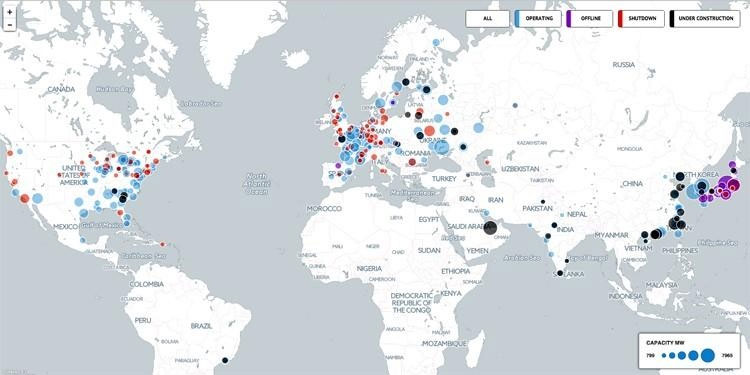The young and ambitious female engineer created carbon-free electricity
The ambition of a young engineer is to use nuclear reactions to produce carbon-free electricity at a cheaper cost than coal and extremely environmentally friendly.
Leslie Dewan , 34, a Ph.D. in nuclear engineering, is studying the feasibility of revitalizing a molten salt reactor at the peak of the global nuclear physics industry.
Step out of the safe zone
In recent decades, the nuclear industry has always brought a lot of fame when rejecting innovative ideas. After many extremely serious incidents such as the US "Three Mile Island" nuclear disaster or Chernobyl in Ukraine, it is feared that the use of nuclear power will lead to similar incidents, no matter what Demand for electricity is increasing.

Portrait of female engineer Leslie Dewan.(Photo taken by Rebecca Hale, National Geographic).
Currently in the world, most use light-water reactor , with old technology. There are issues worth considering about this light water reactor, which is to use ordinary water to cool fuel rods, creating a fusion reaction inside the furnace. In order to prevent radioactive melting if the fuel rods become extremely hot, the reactor protection wall must be thick enough and use expensive materials. In addition, radioactive waste takes up to 100,000 years to disintegrate.

437 is the number of nuclear reactors operating around the world.Among them, the number of light water reactors accounts for 359 (according to 2009 data of the International Atomic Energy Agency IAEA).Blue indicates that the kilns are currently active, purple is suspended, red is no longer active, black is under construction.
The molten salt reactor was first proposed in the 1950s as a solution to power the aircraft.
Compared to light-water reactors, it always requires constant voltage source to pump cooling water, prevent melting of nuclear radiation, molten salt reactor is much safer: reactant itself - molten salt - also acts as a coolant .
However, before the horrific nuclear disaster in human history, it was thought that molten salt reactors seemed too expensive and safer than necessary. Dewan, along with colleague Mark Massie from MIT, USA, updated the reactor design with modern technologies and materials to ensure safety and, of course, significantly reduce cost.
Nuclear reactors run by . radioactive waste
Conventional reactors are fueled by solid uranium oxide powder , which uses only 3% or 4% of uranium energy, so its waste is still radioactive. exist for hundreds of thousands of years. But Dewan's reactor uses uranium as a liquid instead of solids, so it can take up to 96% of uranium's energy.
In case the reactor loses power (as happened in the Fukushima plant after the tsunami), then the reactor in the furnace will heat the valve and cause it to open; The reactant will flow into the tank, the furnace will stop working immediately.

Simple diagram of a light-water nuclear generator with arrow marks denoting closed cycles.Starting from a heat-generating reactor, heating liquid water to create high-pressure steam to spin the generator engine, at the same time the cooling system causes hot steam to return to liquid water to complete the cycle. submit.Explanation: Reactor (Reactor) and red nuclear reactor, Control bar system (Control Rods), Stream Generator, Stream line, Generator Electric (Generator), Generator Turbine (Turbine), Cooling Water, Cooling Tower, Reservoir, Water liquefaction (Condensor), and other Machines Pump

Simple melting salt reactor diagram.
Besides, Dewan and his colleagues have found a solution, a true revolution, about new reactor and reactor designs, increasing power efficiency by 30 times."We found only with small changes in the design of molten salt reactors, could help generate a lot of energy and much cheaper , " she said.
The 180-page long design is simulated by reactor computers, so compact that it can be installed inside other power plants and easily transported by rail, locally assembled. The reactor also uses renewable energy extremely efficiently, it can consume about 1 ton of nuclear waste and leave about 4kg. She calls the oven using this new technology: the Waste-Annihilating Molten-Salt Reactor.
Despite many trials designed and implemented by Dewan itself, it costs millions of dollars to ensure the safety of the furnace. There is still a long and brutal way ahead when putting the whole design into practice.
Dewan represents the generation of young researchers who dare to stand up, for the purpose of the green planet, against extreme climate change.
Dewan used to look at solar energy and wind power as a solution to reduce greenhouse gas emissions , 'but then I look at the numbers, I realize nuclear power is a source of low CO 2 emissions. deployed on the largest scale ' - she said.
- Google changed the logo to honor the first female engineer in the history of world science
- Korea and the United States invented carbon fiber that can produce electricity
- Create electricity from ... air
- Self-winding machine for deep-lying people
- Indonesia wants to take advantage of volcanoes to make electricity
- New approach to generating electricity from the sun
- The calculator is made entirely of micro carbon nanotubes
- Korea's first astronaut is female
- The house itself produces electricity and changes color
- Carbon nanotube can generate large currents
- Stamps for pesticide-free fruit paste
- Carbon bullets, radiation
 The most famous scientific failures in history
The most famous scientific failures in history Mysterious genius mechanic and the machine froze time
Mysterious genius mechanic and the machine froze time The son carries the 'bad gene' of genius Albert Einstein
The son carries the 'bad gene' of genius Albert Einstein Isaac Newton
Isaac Newton